
- •0. Introduction
- •1. A Simple Growth Model
- •2. First Order Autonomous Equations
- •3. Two Approximate Solution Methods
- •4. A Qualitative Method for First Order Autonomous Equations
- •5. The General First Order Linear Equation
- •6. A Qualitative Method for First Order Equations
- •7. Homogeneous Second Order Linear Equations
- •8. Non-homogeneous Second Order Linear Equations
- •9. Additional Applications
- •10. Systems of First Order Equations
- •11. Second Order Equations as Systems
- •12. The Laplace Transform Method
- •14. Some Theoretical Considerations
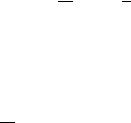
§11. Second Order Equations as Systems
The connection between second order linear equations and first order systems is developed here. This leads to qualitative methods for second order equations which parallel those developed for first order equations.
A simple trick can be employed to transform a single second order linear equation into a system.
Example 11–1. The equation dtd22 x(t) − 5dtd x(t) + 7x(t) = 0 can be transformed into a system as follows. Notice that the second order differential equation gives a relationship between x′′(t) and the functions x(t) and x′(t). This suggests that the vector (x(t), x′(t)) can be used to define a system. By making use of the differential equation, the derivative of this vector can be computed as follows.
dtd x(t), x′(t) = x′(t), 5x′(t) − 7x(t) .
Thus the derivative of the vector (x(t), x′(t)) is expressed in terms of the vector itself.
Since a second order equation can be represented by a system, this same method can be used to study the qualitative behavior of the solutions of a second order equation. In this case the direction field plot for the system is called the phase portrait of the second order equation. The reason for the terminology switch is that the direction field for the vector (x(t), x′(t)) gives information about the behavior of this vector, not just of the single unknown solution x(t).
Copyright 2002 Jerry Alan Veeh. All rights reserved.
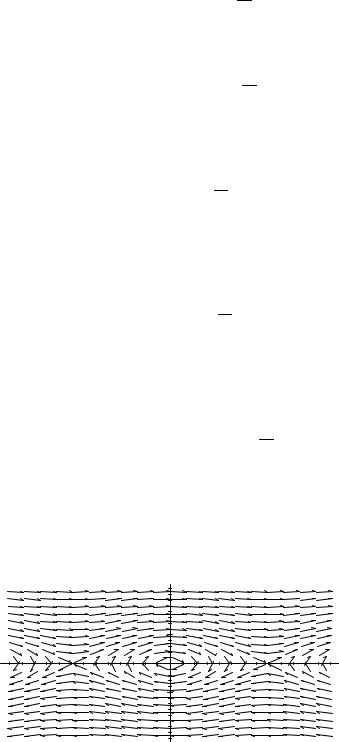
§11: Second Order Equations as Systems 68
Problems
Problem 11–1. Write the second order equation dtd22 x(t) = −4x(t) as a system in vector form.
Problem 11–2. Write the second order equation dtd22 x(t) = 4x(t) as a system in vector form.
Problem 11–3. Which of the direction fields below is the direction field for the system derived from the second order equation dtd22 x(t) = −4x(t)? Use the direction field corresponding to this equation to sketch the solution satisfying x(0) = 1 and x′(0) = 0.
Problem 11–4. Which of the direction fields below is the direction field for the system derived from the second order equation dtd22 x(t) = 4x(t)? Use the direction field corresponding to this equation to sketch the solution satisfying x(0) = 1 and x′(0) = 0.
Problem 11–5. Which of the direction fields below is the direction field for the system derived from the second order equation dtd22 x(t) = − sin(x(t))? Use the direction field corresponding to this equation to sketch the solution satisfying x(0) = 1 and x′(0) = 0.
Direction Field A
|
|
4 |
|
|
|
|
|
y |
|
|
|
|
|
2 |
|
|
|
-4 |
-2 |
0 |
2 |
x |
4 |
|
|
-2 |
|
|
|
|
|
-4 |
|
|
|
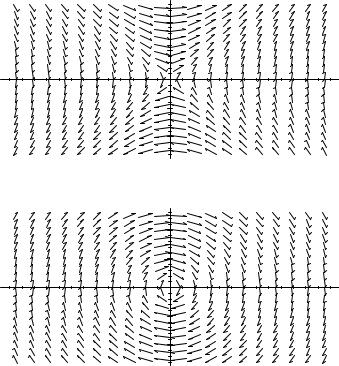
§11: Second Order Equations as Systems 69
Direction Field B
|
|
4 |
|
|
|
|
|
y |
|
|
|
|
|
2 |
|
|
|
-4 |
-2 |
0 |
2 |
x |
4 |
|
|
-2 |
|
|
|
|
|
-4 |
|
|
|
|
|
Direction Field C |
|
|
|
|
|
4 |
|
|
|
|
|
y |
|
|
|
|
|
2 |
|
|
|
-4 |
-2 |
0 |
2 |
x |
4 |
|
|
-2 |
|
|
|
|
|
-4 |
|
|
|
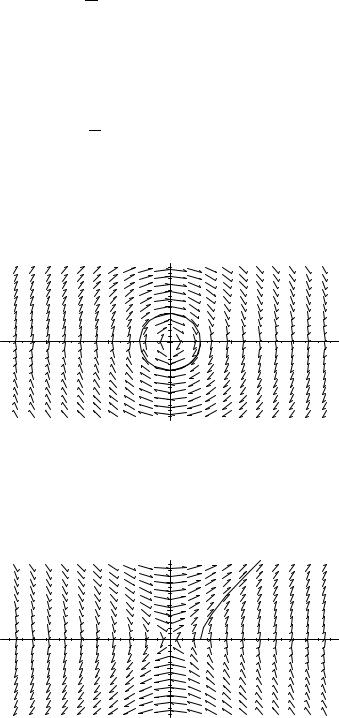
§11: Second Order Equations as Systems 70
Solutions to Problems
Problem 11–1. Using the equation gives
dtd x(t), x′(t) = x′(t), −4x(t) .
Problem 11–2. Using the equation gives
dtd x(t), x′(t) = x′(t), 4x(t) .
Problem 11–3.
Solution of x’’(t)= -4x(t) with x(0)=1 and x’(0)=0
4
y
2
-4 -2 0  2 x 4 -2
2 x 4 -2
-4
Problem 11–4.
Solution of x’’(t)= 4x(t) with x(0)=1 and x’(0)=0
|
|
4 |
|
|
|
|
y |
|
|
|
|
2 |
|
|
-4 |
-2 |
0 |
2 x |
4 |
|
|
-2 |
|
|
|
|
-4 |
|
|
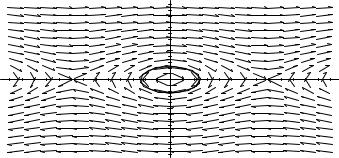
§11: Second Order Equations as Systems 71
Problem 11–5.
Solution of x’’(t)= -sin(x(t)) with x(0)=1 and x’(0)=0
|
|
4 |
|
|
|
|
|
y |
|
|
|
|
|
2 |
|
|
|
-4 |
-2 |
0 |
2 |
x |
4 |
|
|
-2 |
|
|
|
|
|
-4 |
|
|
|
